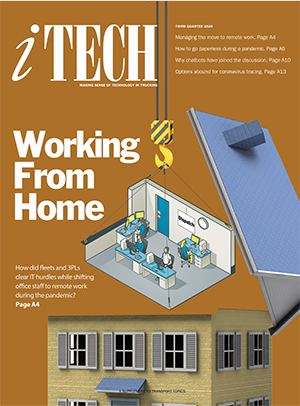Special to Transport Topics
With Workers Shifting to Home Offices, IT Investments Help Keep Freight Moving

[Stay on top of transportation news: Get TTNews in your inbox.]
The coronavirus pandemic and its economic repercussions hit at a time already rife with volatility for the transportation industry, and the need to shift back-office employees to remote work only added to the strain on fleets and third-party logistics providers.
Many credit technology with helping to smoothly and efficiently transition dispatchers and other back-office employees to working from home, while setting up businesses for long-term return on investment.
General videoconferencing applications — such as Skype, Zoom and Microsoft Teams — experienced a widespread popularity boom during the pandemic and have proven useful for easily keeping back-office employees in contact and on the same page with coworkers, in addition to making them more comfortable working from home.
However, industry-specific transportation management systems and dispatch software platforms are playing a large role in helping these employees work remotely by boosting efficiencies while maintaining safe and distant operations.

McGrory
Sunset Transportation, for example, has been utilizing the Descartes MacroPoint capacity-matching platform to help manage its business during the pandemic.
“It’s been a blessing for us to work with that platform in the remote environment,” said Mick McGrory, vice president of strategic account management at the St. Louis-based 3PL.
Last year, Sunset Transportation began testing the Descartes MacroPoint capacity sourcing platform but didn’t fully appreciate the tool’s capabilities until the pandemic struck.
“When COVID hit, [we realized] we have this wonderful tool and we’re going to start using it to produce the return [on investment] we hoped it would have,” McGrory said.
Better realizing the benefits of an existing TMS or dispatch system has emerged as a common theme this year. Other transportation companies found the pandemic to be the impetus they needed to adopt new technologies they already had been considering.
Such was the case for De Pere, Wis.-based Paper Transport, which implemented Trimble’s capacity-matching technology. “We knew we wanted to do this, but it became urgent because of the pandemic,” said Julie Decker, organizational development manager at Paper Transport. “Being able to locate and find freight when the freight market is rapidly going up and down made for an important factor.”

In addition, Paper Transport wanted to make sure it had a system to guide planners’ daily choices and “to really work with Trimble on advancing our brokerage technology to make sure we can continue to leverage all of our services in the remote work environment,” she said.
The pandemic prompted an urgency to be more efficient, Decker added. “In order to remain profitable when economic concerns are in front of us, it’s really important that we manage costs… Time efficiency is one great way to manage costs.”
Achieving that efficiency can be challenging due to the frequent disparities between workplace equipment and what employees have at home, Sunset’s McGrory said.
“When you’re at home, you’re not in [the] office and don’t have six phone lines coming in. You’re not running through the highest-speed internet cable,” he said.
IT departments bear the brunt of ensuring all remote employees have adequate equipment and internet connections, as well as proper firewalls and extra security to allow them to work from networks of unknown integrity.
“We knew we would have users without a computer at home,” said Brandon Teix- eira, IT director at Landtran Systems, which has integrated its system with EBE Technologies’ electronic billing platform.

Read More iTECH Stories
►Clevenger: Trade Shows Go Virtual
►Dysart: Using Technology to Keep Employees Safe
►IT Investments Aid Work From Home Shift
►Adjusting to Electronic Bills of Lading
►Chatbots Reshape B2C Relationship
“I felt prepared when this hit,” he said, because prior to the pandemic each of Landtran’s operating companies essentially was working remotely in their offices while their individual servers resided at parent company Landtran’s corporate headquarters in Edmonton, Alberta.
“We were already technically ‘remote’ so we just took ‘remote office’ and made it ‘remote home,’ ” Teixeira said.
Businesses quickly weighed the security risks of letting employees use their own equipment versus supplying each one with company-approved tools, which proves costly. At the same time, electronic devices were harder to come by early in the pandemic when a plethora of workers across many industries suddenly set up home offices.
Once employees are ready to work from home with the right equipment and network, trucking technology platforms can improve their workflow. Software allows transactions to occur from anywhere and at any time of day without needing to access files or data at the office.
“Those traditional back-end processes are web or mobile enabled and … a biller can work at home or anywhere — they can do their job really well from their kitchen table,” said Larry Kerr, CEO of EBE Technologies. The technology vendor has released a new application centered on easing billing and rate confirmations.
Meanwhile, Descartes enabled a carrier portal during the pandemic that automatically shares available capacity with a few clicks.
“Normally, they might have people in the office doing this work,” said Dan Cicerchi, vice president and general manager of transportation management at Descartes. “On the brokerage side, there’s a general trend of moving toward the cloud.”
This spring, Trimble Transportation launched a dispatch optimization feature called Dispatch Advisor that suggests matches among loads, drivers and equipment.

What does it take to be a commercial driver, and what are schools doing to train them? Host Michael Freeze speaks with Chris Thropp of Sage Truck Driving School and Don Lefeve of the Commercial Vehicle Training Association. Hear a snippet, above, and get the full program by going to RoadSigns.TTNews.com.
“There’s been an increase in interest in optimization products: How do we do the most efficient thing given the current resources?” said Chris Orban, Trimble’s vice president of data science. “As the pandemic arrived, it really forced this shift in how we measure productivity remotely and give people the right tools to do their job.”
Trimble also has partnered with Kuebix, a shipper software provider that it acquired in January, with the aim of streamlining the broader supply chain. In May, the companies released expanded capabilities for Trimble’s Community Load Match platform, which is designed to facilitate collaboration between shippers and carriers.
Transportation businesses increasingly are using digital systems to automate repetitive processes and free up employees for other work. That’s boosting efficiency during the pandemic and will continue to add value when the situation normalizes, industry sources said.
“That’s when desktop robotics really came into play … We essentially tie the different buildouts to our transportation management solutions,” Paper Transport’s Decker said. “It was finding tasks that people might be spending hours on … and allowing the computer system to run [the processes] for people on their behalf. We could then assign them tasks that are critical thinking captures. It’s been an exciting six months.”
The digital systems also make it easier and faster to replicate and share data across different business applications that traditionally require data entry, Kerr said.
Automation improves businesses’ functionality and gives them an edge over competitors, he added.
Decker and Landtran’s Teixeira said that more clients are demanding a switch to paperless transactions, and some will not work with partners who resist going digital.

Decker noticed digital billing adoption “explode in March and April and go into action in April and May.” Customers also are asking for the use of faster, more responsive technologies to track their own freight.
In-platform communication with carriers has become intensely valuable and streamlines remote workers’ daily tasks, Sunset’s McGrory said. Information about open loads and scheduling is shared instantly to speed up business decisions and transactions without resorting to phone calls or back-and-forth emails.
“They’re not wasting time and going through multiple channels trying to get the right people,” he said. “What it means to [employees] is efficiency from home … Our usage of that tool has grown dramatically since the pandemic occurred.”
He looks forward to the technologies advancing further to include additional reporting capabilities for even greater return on investment. Still, he said Sunset already has noticed increased performance since adopting the capacity-matching system, for the daily ability to cover a load and for larger, long-term projects.
Technology vendors suggested the array of customer benefits from adopting more sophisticated TMS and dispatch software means there’s no going back after the pandemic passes.
“The shift, I think, has been in the making, but maybe it took what would have happened over the next 12 or 18 months and pulled it forward into just two months,” Descartes’ Cicerchi said.
Vendors anticipate even more product refinement and new features in the coming months to support a remote workforce as transportation adjusts to the new normal.
“There are still questions to be asked, and it’s up to us as an industry to answer them,” Trimble’s Orban said. There’s no one solution … but together we’re going to figure out a way forward.” ³
Want more news? Listen to today's daily briefing:
Subscribe: Apple Podcasts | Spotify | Amazon Alexa | Google Assistant | More




